The Light and The Flame |
AGUDAS ACHIM, Superior, Wisconsin |
Few immigrant groups arrived in the US with more pent-up energy than the Jews. Virtually excluded from citizenship and political participation in eastern Europe until the run-up to the Russian Revolution, most dove head-first into American life. In the space of two generations they had made up for lost time. Most, but not all. Some did not dive in; some barely put a toe in the water, and would not readily admit there was a difference between Superior and Smolensk. They carried on almost as if their geographical translation had not occurred. Their beacon was a spirtual Light. For others living at the western tip of Lake Superior it would become a unique restaurant called The Flame.
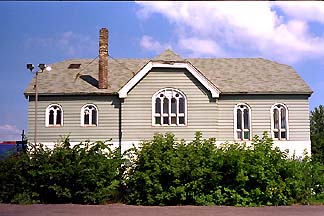
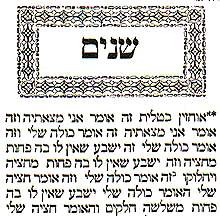
The Light...
Small-town Jewish America followed a predictable 3-generation course from beginning to end. The greeners worked seven days a week to gain a foothold; their children, real Yankees now, diligently followed in their footsteps and consolidated their gains; but the grandchildren took the money, if they could, and ran--from the limitations of small trade, from the smallness of small towns, to a larger hevra and greater choice in the bigger cities. Their parents and grandparents had traded a threadbare existence in an alien Europe for the friendly security of American citizenship. They knew a good deal when they saw it and gladly paid the price: jump in, be an American, shed your foreign-ness!Taharas hamishpochahfell away, kashruthattenuated, and Shabbos and most of the holidays were observed by the hour instead of the day. As they melted into the mainstream, the vitality of their communities slowly evaporated.
Agudas Achim did not evolve; it was there and then it was gone. None of the founding members of the congregation had any intention of compromising their Jewish values and practices as they arrived in Superior from various points in eastern Europe. And through the 100 years or so of its existence, many didn't. Arnovich family members began to arrive in the first decade of the century from the small town of Preilin the Latvian district of Latgale. The last, the family of Rabbi Moshe Zelig Arnovich, turned up in 1922, an event heralded in the local paper...
He would serve the congregation faithfully until his death in 1942, and his son, Eliyahu (Alex) would carry on from 1945 till 1977. During all that time there was a minyan of shomer shabbos (Sabbath observant) congregants morning and evening, and a gemara shiur (Talmud class) at least once a day and often twice. In most towns there were always one or two pious men who would soldier on, but an active congregation far beyond the magnetic pull of a large metropolitan area was rare beyond statistical significance. There is no other reason except rabbinical leadership of a kind that may be called heroic.
The place, the people were an oddity, practically unknown even in Duluth across the bay. A chronicler of local Jewish history, whose nostalgic column has appeared in the Jewish Fellowship News for many years, when asked if any talmidei chachamim(scholars) ever lived in the area, answered, "naw, why would they come here." Indeed! They existed in isolation and obscurity, contrary to the prevailing trends in Jewish life everywhere around.
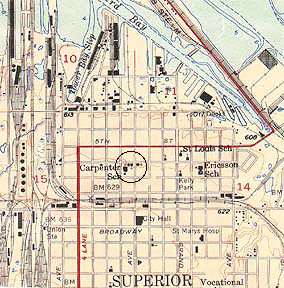
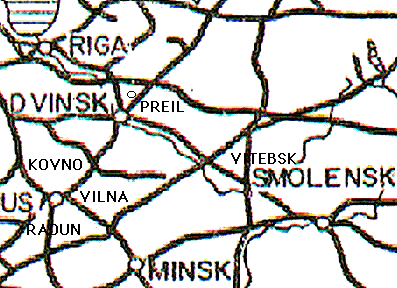
"I never asked him...."...is what he said, is what Rabbi Alex Hyatt said in his still-thick Yiddishaccent when asked if his grandfather told him stories of Superior long ago. The interviewer's question puzzled him, and his answer suggested it would have puzzled his grandfather too. Superior? What difference did it make? Superior had been an accidental destination and was an incidental backdrop--if less dangerous than Eastern Europe then less Jewish too. Freedom, like everything else, suffered from the defects of its virtues.
How "Arnovich" became "Hyatt" is a typically untypical story: Preil is a nice town, has always been when left to itself. It lay, however, in a political flood plain variously inundated by Germanic or Slavic forces. In 1914 then loosely held by Russia the territory was threatened by advancing German armies. Moshe's two sisters and his grandfather fled eastward to Smolensk to wait out the war. By 1917 the problems of the war were compounded by the reverberations of the Bolshevik revolution. Facing imminent conscription into the Czar's army Moshe sent his wife, Leah Tirtzerl, to Smolensk to buy "papers" to provide him with a draft-proof identity. The unrecorded death of a Mr. Hyatt, lately from Smolensk, furnished a passport whose address and picture could be altered, for a price, to fit her husband.
In a week's time the political situation had turned chaotic--The Red Army had decisively defeated the White Russians. Transport was disrupted; one could not travel west toward Riga from Smolensk without changing trains in Pinsk. Arriving passengers in Pinsk, however, were forced off the train by the Bolsheviks looking for spies, traitors, and provocateurs. Moshe's wife was detained on suspicion. It was no secret what would happen to anyone caught with suspicious documents. To the Bolsheviks life was cheap. She cried hopelessly, waiting on a station bench for the interrogator to summon her.
A boy of 8 or 9 approached and whispered in Yiddish, " Don't cry, give me everything you're afraid of." He explained that his father was a kosher butcher in town and she could find him later. She gave the boy everything: her husband's "Hyatt" passport, her "Arnovich" passport, her purse. The boy disappeared. She was questioned and searched. Where were her documents, her purse? Snatched by thieves--the station was so crowded--she didn't know, she didn't know. They tried hard, looked everywhere, but found nothing and let her go.
Outside the station she asked a Jewish porter, "Where can I find the katsev?" You mean "Boruch HaKatsev" Boruch the Butcher, and showed her the way. His shop was about a mile from the station and he was there, with her papers. Did he know his son had saved her life? Yes, he goes to the station everyday and has saved many Jewish lives. No need for thanks, it is what we do.
So, in 1922 when the Moshe Arnovich family arrived in Superior, they became Hyatts. One sister who had remained too long in Smolensk was not able to leave Russia until 1975, her son in 1985. It was just as well: the 892 Jewish souls who remained in Preil were rounded up by the Nazis and shot in the woods just outside of town. Rabbi Moshe left Superior only twice--to attend his sons' weddings in Marinet, WI and Columbus, OH. Julius Hyatt went away to Yitzchok Elchanon Yeshivah (later Yeshivah University) in New York, became a Rabbi and served in Peoria for over 40 years. Alex moved away early in 1939 and was gone for the duration of the war. Rabbi Moshe died in 1942 and Rabbi Alex took his place when he returned in 1945.
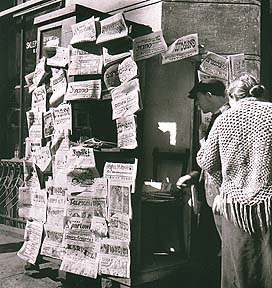
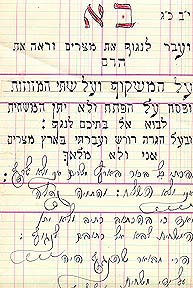
Old and New...
In the Old Country where there was little choice for Jews but to be Jewish, they were. A rich and observant Jewish life was normal: daily newspapers, guest houses, study halls and yeshivahs, people to talk to and people not to talk to. There were differences of landscape and climate, dress and architecture, politics and economy between the old world and the new, but they didn't approach the significance of the fullness of Jewish life. The rhythm of the year felt all around the town--Shabbos and holidays and simchas. Boys were commonly sent off to Yeshivah, instead of university, to learn: Rabbi Moshe to Ramailes in Vilna, Rabbi Alex to Chafetz Chaim in Radun, then popular with many boys from Preil. The great Yeshivahs of Slobodka, across the river from Kovno, and Volozhin were also close by. Jewish merchants and mechanics in town serviced the many farms round about. Twenty-five or so men gathered each weekday morning to learn in the beis midrash. The place had a Yiddische taam, and considered altogether, life in Preil was sweet.
In the New World there were too many choices and most of them were even available to Jews. An observant Jewish life was just another choice, and rarely first. Many of the Jews who fetched up in the middle of nowhere, simple Yiedden, hadn't much learning. They knew what to do in shul and at home, but not much more. Making money was more fun and its rewards were more obvious, immediate and liquid. Those who had mastered theGemara and the commentaries lived in another world altogether, one in which the context was subordinate to the content. If the learning was good, it wouldn't matter much if one lived in Superior or Slobotka. For those without learning the very name "Slobotka" was funny ("Motke from Slobotka" was a popular local humor column). Not many knew much at all. There was Rabbi Kopstein across the bay in Duluth, but Rabbi Moshe Hyatt really had no equal. He performed his duties with conscientious dedication, but he always regretted having left Europe. He remained in a world apart, often waking at 3AM to learn until shacharis (morning prayers). Superior had for him a goyische taam; and America seemed, despite its benefits, a treife medina.
What was it that was missing? Learning! Not the simple skill of reading Hebrew, chanting the prayers and Torah portions for the day of Bar Mitzvah, but the rigorous, mind-wrenching, daily attachment to the beis midrash (communal study hall) for the study of Torah, Talmud, the commentaries, kaballah,halachah (Jewish law). In Europe it went on in every home, every town and it infused everyday life with the spice of kedusha (holiness). And in the new world--almost nothing. The passage above begins the first perek of Baba Metzia --Two people were holding onto a garment and one said, "I found it," and the other said, "I found it," or one said, "it's all mine," and the other said, "it's all mine," then each must swear an oath. claiming not less than half the garment. Then they divide it between them. Boys of eight or nine traditionally begin their study of the Talmud with this tractate. In the new world adults might stumble on the first word and be clueless thereafter. An effective interpretive mechanism, the refracting prism through which the whole world was viewed in a uniquely Jewish way, was simply missing.
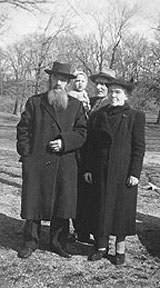 This article appeared in the local paper
under the ominous headline, "Know Your Church," ...
This article appeared in the local paper
under the ominous headline, "Know Your Church," ...
There were actually two shuls a block apart: Agudas Achim, the Litvische Shul, and the Superior Hebrew Congregation, the Russische Shul. Until WWII the difference was largely a matter of national origin, both were rigorously Orthodox institutions. After the war their paths diverged sharply. Rabbi Alex Hyatt returned to lead Agudas Achim, but the Russische Shul had no rabbi. In 1947 to more easily entice an appropriately "American" rabbi to come to Superior and as a reflection of changing religious habits of the congregation, the Superior Hebrew Congregation officially affiliated with the Conservative movement. Rabbi Moshe Hyatt never spoke more than a few words of English, and Rabbi Alex could not keep his English engaged very long before slipping back into themama loschen. The children and grandchildren of first generation members of Agudas Achim slowly leaked away to what had become a philosophical and religious rival. In 1964 it moved out of the old blue-collar, dockside neighborhood and into a new building, now called, appropriately, Temple Beth El. The Russische Shulbarely existed as a memory and its descendant had been wholly absorbed into the American mainstream.
Agudas Achim would not be absorbed at all. Rabbi Hyatt explains proudly that while anyone could be a member of his shulno one could daven from the amud (lead the congregation in praryer) who was not shomer shabbos. (sabbath-observant). In the Temple there was no one who was shomer shabbos. What he remembers that was important: a daily Gemara shiurafter shachris and between minchah-maariv. Beth El spiralled into oblivion and faded away, but Agudas Achim just stopped dead.
The ten men for the minyan were no longer easy to get; stay-in-beds had to be called, then chauffered to shul. In the winter even the best-willed men froze in place and would not budge. When there were no longer even ten men left, Rabbi Hyatt considered his duty done and retired with his wife to Washington DC where he had family. Those few members who remained continued to show up out of habit. Even when a stranger showed up to fill the quorum, there wasn't always someone qualified to lead the davening anymore.Until an East-coast sharpie breezed into town from New York City and who knew where else. They were desparate and the sharpie could daven. But he had a shady past and a shaddier local sidekick. No one asked too many questions even when small items began to disappear.
Then a Torah disappeared, and turned up only after an unusual coincidence. A workman noticed a blue-velvet-covered cylindrical object in the basement of a nearby house, and knew it to be aTorah only because of a TV show he had seen shortly before in which the plot revolved around a stolen Torah.It was promptly recovered by the Police but the six remaining members of Agudas Achim had had enough, voted to shut the place down, and soon found a buyer willing to pay $30,000 for building.Then, for their grande finale the sharpie and friend demanded 25% of the sale price, claiming to be members seven and eight respectively. And where were the records to prove they weren't?The archives from 1895 to 1985, had mysteriously disappeared and were never recovered. Faced with a difficult and likely wrenching legal battle, the old guys just locked the doors and walked away. And that was it!
Except for bums escaping the bitter winter cold and kids up to no good, the place remained as it was until this work was done in the spring of 1998. Tefillin and siddurim were scattered around; the parochet (ark curtain) had lately been used as a bedspread; flocks of pigeons had used the building as a dovecote; and more than one campfire had toasted the walls here and there.(more as-is photos)
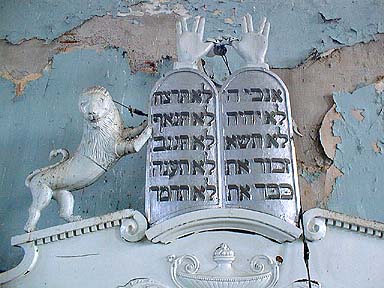
Although the builders of Agudas Achim were not in 1907 sophisticated architectural clients, they were, as first generation immigrants, able to sketch from their experience in the old country just how a proper synagogue ought to be arranged and what it should look like, more or less. The result here as elsewhere in the US is an amalgam of old world forms and new world construction methods and materials. The cross-section of the synagogue at Lutomiersk (late 18th century) Poland indicates a very rough resemblance in terms of overall size and seating capacity, window placement, and ceiling decoration.
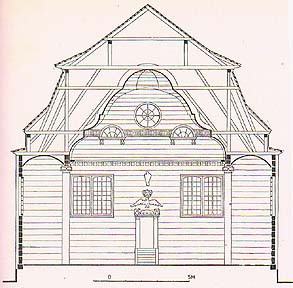
The bimah was typically located in the center of the hall, but to gain extra seats it was, as here, pushed to the front and combined as a unit with the davening lectern just in front of it. The women's balconey solved the halachic problem of separation between men and women without impeding women's ability to see and hear what was going on. Although they could not participate in the service, they paid close attention to who was doing what. The hand-lettered poster in Yiddish lists the rules or qualities required of the sheliach tzibur: be observant, have a nice voice, know how to daven, speak nicely to and about people, be a mensch.
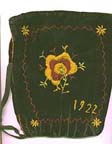 They locked the doors and left everything
inside: tefillin, tallesim, siddurim,
They locked the doors and left everything
inside: tefillin, tallesim, siddurim, 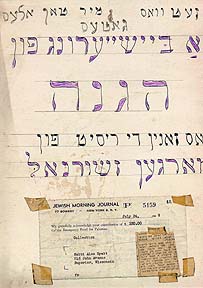 chumashim--all
but the Torahs were still in place as if they might return momentarily
and resume davening. But, they have never quite managed to gather
a minyan again. Now there's no one left to call.
chumashim--all
but the Torahs were still in place as if they might return momentarily
and resume davening. But, they have never quite managed to gather
a minyan again. Now there's no one left to call.
The home-made poster (on the back of an election placard: "Elect Clyde B. Thomas (veteran of WWI) Country Clerk") displays a receipt which appeared in the Jewish Morning Journal in New York for member contributions to the Palestine Emergency Fund, 24 July 1948 ---including: Yehuda Leib Karon, Pesach Gittleman, Yisroel Pomish, Yaakov Wiener, Moshe Plast, Meir Seigel, Yehuda Leib Witkin, Z. Levinson, Dov Baer Cahan, K. Goldberg, Baruch Shaul Milevitz, H. Hanoch Kaner, Avraham Yaakov Weinshtein, Chiam Weinshtein, Eli Yosef Bernshtein, Chanah and Eliazar Levine, Yehuda Goldberg, Chiam London, Yosef Shapira, Shmuel Tzukar, Chiam Bergshtein, Chana Barkovitz, HaRav Eli Haiet, Avraham Yosef Cahan, and Mordechai Kadoshovitz. $230.00 was raised.
The first services of the Superior Hebrew Brotherhood Congregation were held in Sam Kaner's house in 1889. Fifty-three years later, at the age of 97, blind, deaf, and supposedly bed-ridden, they found him in the street crawling to Yom Kippur services. His five sons, Izzie, Henry, Abe, Hyman, and Lawrence contributed to the family income by peddling tobacco and sundries to the sailors on the docks, just a few blocks from their neighborhood. By the late twenties they were peddling by boat, a "bum-boat," and were taking their merchandise right up to the loading ships.
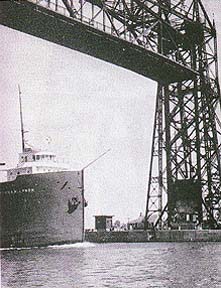
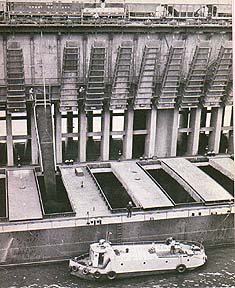 While Ben Overman held
the franchise for the Mesabi docks in Duluth, the Kaners handled
the greater traffic coming to load iron ore at the Allouez docks
in Superior. At the height of the business in 1957 they operated
5 boats offering everything a man alone could want: clothing,
shoes, magazines, gifts, jewelry, beer, soda, and a place to drink
it. All packed into the elongated cabin of a vessel whose length
was 55' and beam 17'. At one time they were the largest distributor
of panasonic radios north of Minneapolis.
While Ben Overman held
the franchise for the Mesabi docks in Duluth, the Kaners handled
the greater traffic coming to load iron ore at the Allouez docks
in Superior. At the height of the business in 1957 they operated
5 boats offering everything a man alone could want: clothing,
shoes, magazines, gifts, jewelry, beer, soda, and a place to drink
it. All packed into the elongated cabin of a vessel whose length
was 55' and beam 17'. At one time they were the largest distributor
of panasonic radios north of Minneapolis.
By the late '50's times were changing. The St. Lawrence Seaway
opened bringing saltwater vessels whose crews were paid a fraction
of the American ore carrier crews and lacked the funds to do more
than window shop amidst the bumboat merchandise. The lake freighters
grew in size as their cargo increased in density, and their crews
diminished in number. The rich red ore of the Mesabi range began
to play out just after WWII and beneficiated taconite pellets
with 3 times the iron content (and density) took its place. The
work of three ships could nominally be done by one and the newer
ships sailed a longer season. The 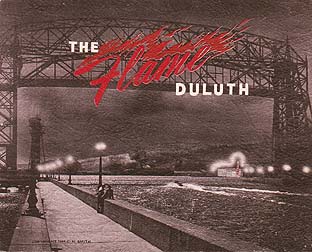 bumboat
customer base shrunk dramatically.
bumboat
customer base shrunk dramatically.
But tourism increased. Families hit the road in search of 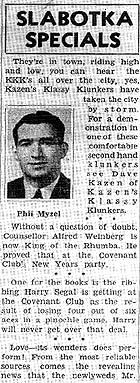 scenic
wonders, and the Duluth-Superior harbor was a big attraction to
folks in the midwest. The Kaners, along with a colorful Polish
businessman named Gazonsky, outfitted a harbor sightseeing boat
dubbed the Flame, as a result of a deal with the proprietor of
the Flame restaurant, Jimmy Oreck. They set up shop at the Flame's
dock and sold tickets in the lobby. While the tourists sprung
for tickets for the harbor tour, they passed up the Flame's celebrated
food and Charlie Casmir's drinks upstairs. Jimmy continued to
ring the ship's bell at the top of the stairs to announce in his
peculiarly toneless voice the vital statistics of each ship looming
huge beyond the big picture windows of the main dining room: "Ladies
and gentlemen, now passing, the D. G. Kerr, downbound for South
Chicago with 13200 ton of ore loaded at the Mesabi docks. She
has a length of 600' and a beam of 60'. Owned and built
by US Steel she made her maiden voyage in June of 1916."The boat business was later sold to the Goldfinefamily, who continue to operate it to this day.
scenic
wonders, and the Duluth-Superior harbor was a big attraction to
folks in the midwest. The Kaners, along with a colorful Polish
businessman named Gazonsky, outfitted a harbor sightseeing boat
dubbed the Flame, as a result of a deal with the proprietor of
the Flame restaurant, Jimmy Oreck. They set up shop at the Flame's
dock and sold tickets in the lobby. While the tourists sprung
for tickets for the harbor tour, they passed up the Flame's celebrated
food and Charlie Casmir's drinks upstairs. Jimmy continued to
ring the ship's bell at the top of the stairs to announce in his
peculiarly toneless voice the vital statistics of each ship looming
huge beyond the big picture windows of the main dining room: "Ladies
and gentlemen, now passing, the D. G. Kerr, downbound for South
Chicago with 13200 ton of ore loaded at the Mesabi docks. She
has a length of 600' and a beam of 60'. Owned and built
by US Steel she made her maiden voyage in June of 1916."The boat business was later sold to the Goldfinefamily, who continue to operate it to this day.
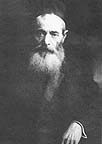
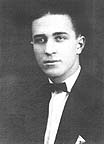
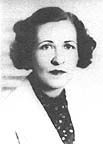 The Flamewas something. It had style, it had class, it was raffish. Then
so were its owners, Jimmy and Ruth Oreck. Jimmy was of the first
American-born generation of Rafuel
Avrumovich Oreckovsky, "The Zaideh", and Ruth (neePeterson) the beautiful daughter of Danish immigrants from Brainerd,
MN. They stretched the chain as far as it would go--maybe farther.
Jimmy, though famously laconic, possessed matinee-idol good looks,
and knew how to run a restaurant. Jews could go to the Covenant
Club for family affairs and simchas; they couldn't set foot
in the front door of the Northland Country Club or the Kitchi
Gammi Club--not till much later. Everyone who was anyone wanted
to go to the Flame for a big time, and everyone else just wanted
to be able to afford a meal there. The Flame was in its way the
local embodiment of the American dream.
The Flamewas something. It had style, it had class, it was raffish. Then
so were its owners, Jimmy and Ruth Oreck. Jimmy was of the first
American-born generation of Rafuel
Avrumovich Oreckovsky, "The Zaideh", and Ruth (neePeterson) the beautiful daughter of Danish immigrants from Brainerd,
MN. They stretched the chain as far as it would go--maybe farther.
Jimmy, though famously laconic, possessed matinee-idol good looks,
and knew how to run a restaurant. Jews could go to the Covenant
Club for family affairs and simchas; they couldn't set foot
in the front door of the Northland Country Club or the Kitchi
Gammi Club--not till much later. Everyone who was anyone wanted
to go to the Flame for a big time, and everyone else just wanted
to be able to afford a meal there. The Flame was in its way the
local embodiment of the American dream.
Rafuel Oreckovsky and Moshe Arnovich spoke the same language, lived the same kind of life. They may even have sat at the same table learning in the beis midrash at Agudas Achim or Adas Israel in Duluth. Sharing a table with Jimmy and Ruth at the Flame was beyond imagining, beyond the pale as it were. However, it was not all black and white. Rabbi Julius Hyatt asked as we rode in the car through Silver Springs, MD, "Did you knowMorrie Arnovich was a first cousin. Grew up in Superior, played for the Phillies..." He mentioned it more than once. It is the way things happened there.